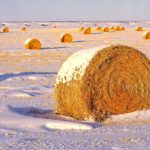
Tag Archives cattle feeding

A year of green grass and more
Prime Cuts with Steve Kay: from the January 2017 issue of Canadian Cattlemen
Another year has begun and expectations on both sides of the border are for a decent year. Cow-calf producers hope for a mild winter but enough snow to produce a lot of green grass this spring and a good calving season. Cattle feeders hope to see more feeder cattle and a more stable live cattle […] Read more

Concerns with feeding off-grade grain
Nutrition with John McKinnon, beef cattle nutritionist
In the September issue of Cattlemen, the title of my column was “Another crazy year for growing hay.” In that column I looked at some of the trials and tribulations that hay producers faced this past summer. Looking at this year’s harvest, you can’t blame grain producers for thinking that a similar dark cloud hangs […] Read more

Get the most from weathered feed
Feed: News Roundup from the November 2016 issue of Canadian Cattlemen
Weather cut a harsh swath through winter feed supplies all across the country last month causing headaches for cattle producers who were scrambling to salvage what they could from the leavings. In Alberta early snow covered many acres of annual crops grown for greenfeed, raising concerns that it may not dry before it had to […] Read more

Declining cow-calf margins slow expansion
Prime Cuts with Steve Kay from the November 2016 issue of Canadian Cattlemen
The cow-calf sector is the nursery of the North American beef industry. What happens on the ranch determines whether the industry will expand or contract. This then determines what happens all the way to the retail meat case or the restaurant menu. Cattle numbers in recent years have shown different patterns north and south of […] Read more

Feeding and pen environment
Canadian feedlot animal care assessment — Part 5
The starting point for assessing a feedlot’s nutrition and feeding program is documentation about the feeding program along with feed records, either on a computer or hard copy. Ten points are awarded for working with a nutritionist and/or veterinarian to ensure rations meet requirements for all classes of cattle, along with two points for each […] Read more

Western Feedlots is gone, what now?
News Roundup from the October 24, 2016 issue of Canadian Cattlemen
As our October 24 issue went to press, people across the industry were still trying to assess the impact of the surprise September 22 announcement that Western Feedlots Ltd. is mothballing its feeding operations. The company plans to feed out the remaining cattle at its High River and Mossleigh yards until sometime in early 2017. The […] Read more

From the bottom up, this barn has it all
It's the only one of its kind in the Ottawa region
Beef Farmers of Ontario’s ninth annual cow-calf roadshow stopped for a sneak preview of a new feeder barn at Foster Farms, near North Gower, Ont., that was slated to start receiving cattle at the end of September. The 120 x 650-foot barn is the only one of its kind in the Ottawa region and one […] Read more

Cattle marketing challenges continue
Prime Cuts with Steve Kay, from the August 2016 issue of Canadian Cattlemen
Grilling season sizzle inevitably gives way to the dog days of summer, when Americans stay indoors and eat cold cuts rather than steaks. This means the live cattle and wholesale beef markets usually put in their summer lows in late July. As temperatures moderate, beef sales pick up and allow the cattle and beef markets […] Read more

Understanding cattle markets
Whenever I provide a market outlook for a producer group or convention related to beef production, I always start off by asking how many producers subscribe to market information. Inevitably, maybe three or four hands go up. The market outlook is always the last topic of discussion at the convention and needless to say, given […] Read more

Sustainable beef is within our grasp
McDonald’s Restaurant project set the tone for Canadian beef industry
Alberta cattleman Bob Lowe didn’t have to do any management back flips on his ranch to produce cattle that under a recently completed pilot project qualify as “verifiable sustainable beef.” He has always aimed to apply sound production and environmental practices with his 500-head commercial cow-calf operation and 7,000-head-capacity southern Alberta feedlot. He and family […] Read more



